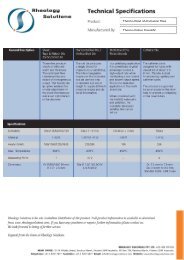Download - Rheology Solutions
Download - Rheology Solutions
Download - Rheology Solutions
Create successful ePaper yourself
Turn your PDF publications into a flip-book with our unique Google optimized e-Paper software.
application notes & technical articles<br />
Rheological Properties of Fresh<br />
Building Materials<br />
After the introduction of the OICCC standard<br />
recently, rheological tests are a must in the<br />
industry for quality assurance of the chocolate.<br />
They include measurements at different shear<br />
rates up to 60s -1 to be performed after a defined<br />
pre-treatment of the chocolate. With the<br />
computerised rheometers available today the<br />
measuring conditions and procedures can be<br />
preset so that most of them can be carried out<br />
automatically by the push of a button. This will<br />
reduce the time effort for routine tests drastically<br />
and the saved work capacity can be used<br />
otherwise. However, even when working<br />
accurately and, on the first glance, with identical<br />
pre-treatment of the samples the results can<br />
differ considerably especially in comparison with<br />
tests performed by someone else and with<br />
different instruments. Some of these<br />
measurement-related aspects should be<br />
biennial 07-08<br />
construction &<br />
building industries<br />
The rheological behavior of building material<br />
suspensions plays a central role in the<br />
processability of cement bonded building<br />
materials and thus also in the rheological<br />
behavior of their properties in hardened state. On<br />
account of the widely spread application of very<br />
different admixtures and materials, the empirical<br />
test methods at disposal are, up to date,<br />
inadequate in their validity for assessing the<br />
rheological properties of these materials in fresh<br />
state. Investigations with the rotational rheometer<br />
– HAAKE RheoStress 600 – however, enable a<br />
comprehensive description of the rheological<br />
behavior of these materials.<br />
Different problems with the description of the<br />
rheological behavior of fresh building material<br />
suspensions will be briefly explained in this<br />
article. Finally, individual measuring methods for<br />
application notes & technical articles<br />
Experimental Influences on the<br />
Casson-Viscosity. The Casson<br />
Yield Point for Chocolate Testing<br />
food industries<br />
introduced and explained. However, the<br />
dependence of the flow properties of chocolate<br />
on their composition will not be discussed here.<br />
History<br />
From the rheological point of view chocolate is<br />
not an easy fluid: it is a suspension of cocoa,<br />
sugar and solid milk particles in a continuous fat<br />
phase. The mix of the substances and their<br />
interactions are strongly dependent on production<br />
and pre-treatment. The yield point of chocolate<br />
e.g. increases with longer tempering time since<br />
the cocoa butter is already partly crystallising (i.e.<br />
physical networks are forming which have to be<br />
broken off before a possible shearing). In order to<br />
obtain comparable results special attention has to<br />
be paid to the correct reproducibility of the pretreatment<br />
of the sample (there are tolerances<br />
even within the OICCC standard which can have<br />
their effects on the results, e.g. the cooldown/tempering<br />
times when filling the chocolate<br />
determining these properties, as well as the<br />
results that were won in the scope of an<br />
investigation program for the development of<br />
pumping-capable self-compacting light-weight<br />
concrete will be introduced.<br />
A full copy of “Rheological Properties of<br />
Fresh Building Materials” is available by<br />
quoting reference no: V-217<br />
into the rheometer). The differences occurring for<br />
thixotropic chocolate are especially dramatic:<br />
Here, the viscosity depends on the stirring time<br />
(shearing time).<br />
However, allowing sufficient time for preshearing<br />
can eliminate errors (the necessary time can be<br />
determined by test with a constant shear rate).<br />
Two successively recorded flow curves of a<br />
sample of a nougat cream available on the<br />
market (measuring time 3 min each) which also<br />
had a different history is shown. A slight decrease<br />
of the viscosity can be detected which can be the<br />
result of the small thixotropy but also of<br />
sedimentation or homogenizing effects by<br />
shearing.<br />
A full copy of “Experimental Influences on<br />
the Casson-Viscosity...” is available by<br />
quoting reference no: V-129<br />
6 www.rheologysolutions.com










